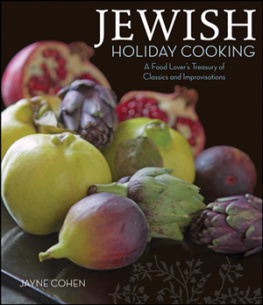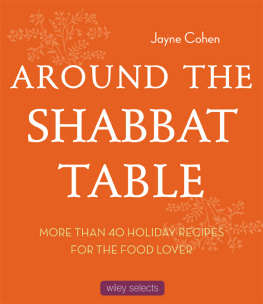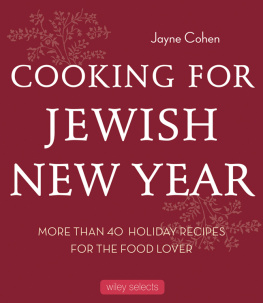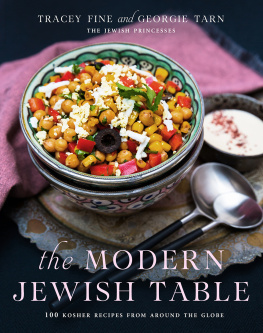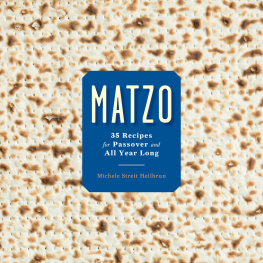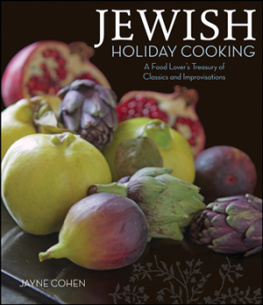
Passover
1421 Nissan (March or April)
All people, in every generation, should see themselves as having experienced the Exodus in Egypt.
Passover Haggadah
A generous ransom paid for a much sought-after piece of broken matzoh. Horrific plagues re-created out of wine drops, and bricks from a scrumptious fruit and nut paste. So many raucous cousins, the dining table must be stretched with bridge tables until it snakes around the front door.
At every Passover seder Jews revisit magical childhood memories.
A glorious ceremonial family dinner held on the first and second nights (Israelis and Reform Jews observe one night only) of Passover, the seder brings to life the ancient Hebrews liberation from slavery and their flight from Egypt. Nearly 80 percent of North American Jewsand many non-Jews as wellattend a seder every year, making Passover the most celebratedand best-lovedof all the Jewish holidays.
The story of the Exodus is a universal one, a struggle for political liberation and spiritual freedom relevant to all peoples. Moses, as Gods emissary, pleaded with Pharaoh to free his peoplethe enslaved Hebrews who, smarting under the taskmasters whips, were forced to build Egyptian cities. To convince the nefarious king to heed the request, God visited nine monstrous plagues on the Egyptians, ranging from boils on their skin to frogs in the water to total darkness. Still Pharaoh would not relent. Finally, God sent the worst curse of all: the death of the first-born males, and Pharaoh at last conceded. That night the Hebrews ate a hurried meal of roasted lamb and unleavened bread and fled in haste, lest he change his mind.
And that he did. Now the Hebrews stood before the Red Sea, and behind them, they could feel the hot breath of the Egyptian pursuers mingled with the desert scorch. Moses lifted his arm and miraculously the waters parted so that they could pass through to safety. When the last Hebrew reached the shore, Moses returned the waters to their natural state, drowning the Egyptians and their chargers.
It is a stirring tale, meant to be felt, not merely told, and the injunction above, to relive the Exodus personally, is taken seriously. The symbolic seder foods are used to make the narrating vivid, and because most of these foods are consumed, we actually taste the experience and ensure it will become a part of us.
The matzoh recalls not only the flat, unleavened bread quickly prepared for the flight from Egypt, it also suggests the humility of the Hebrews first as slaves, and later as grateful worshipers before God. They had become acquainted with yeasted bread in Egypt, so leavened bread (and by extension, any form of leavening), puffed and swollen as with vanity and pride, symbolized their Egyptian oppressors. Jews are prohibited not just from eating leavening ( hametz in Hebrew) during the eight days of Passover, they must fastidiously remove every crumb of it from their homes. This is a holiday of freedom and every trace of the tyrants must be cleared away.
After the meal, a piece of matzoh stealthily hidden by the leader of the seder becomes the object of a treasure hunt for all the children. Whoever finds this afikomen (the word means dessert in Greek) will demand a ransom (contemporary requests run from cash to charitable contributions to video games), for the meal cannot be concluded until it is eaten.
The focus of the table is the special seder plate filled with other ritual foods from the Passover saga. The highly symbolic egg, eaten extensively throughout the holiday, appears on the plate either roasted or haminado , Sephardi-style. It speaks of many things. Primarily, it recalls the festival offerings brought to the Temple in Jerusalem, and, as a symbol of mourning, reinforces our sense of loss at the Temples destruction. But paradoxically, it also stands for the eternal and for new life, the hope and optimism that are evoked with every spring. A roasted lamb shank bone (sometimes replaced by a chicken wing or neck or even, for vegetarians, a roasted beet) brings to mind other sacrifices at the Temple.
Salt water or vinegar gives us a taste of the tears and hard sweat of slavery, but it is tempered by the sweet vegetable we dip into it: parsley, celery, or soft lettuce, representing the renewal and growth of spring. Horseradish, arugula, romaine, or other bitter herbs sting our tongues with the harshness of slavery and oppression. And everybodys favorite is haroset, which mimics the brick and mortar the Hebrews used to build Pharaohs cities. Variations on this fruit-and-nut theme reflect all the myriad foodstuffs available in the Diaspora. Classic Ashkenazi haroset calls for simple ingredients easy to obtain in Central and Eastern Europe: chopped apples and walnuts or almonds flavored with cinnamon and wine. Sephardis could choose from the exotic pantries of the Mediterranean. Their luscious mortar might blend pureed dates and wine with chopped walnuts. Coconut, pomegranate, lemon juice, pine nuts, and chestnuts are just a few possible additions.
The joy symbolized by the four cups of wine (or grape juice) each celebrant drinks during the seder is not complete: recognizing that our enemies, too, suffered during the Exodus diminishes our gladness. So, with one finger we flick out a drop of wine for each plague visited on the Egyptians. The door is opened during the service so that the Prophet Elijah, harbinger of peace and the Messianic Age, may come in to drink the cup of wine poured for him. Everyone watches this goblet closely to see if he has sipped, a sure sign of Gods blessing.
Today some seders feature a special goblet, the Kos Miryam (Miriams Cup), created by a group of women in the 1980s. The cup is filled with water and honors Moses sister, who provided the Israelites with water from a well that followed her throughout the wandering and dried up when she died. (For more specific details on preparing these ritual items, please see .)
The ceremonies are spelled out in a special book called the Haggadah. To date, more than 4,000 printed (and countless hand-lettered) versions have been created; as Yosef Hayim Yerushalmi wrote in Haggadah and History , it has been reprinted more often and in more places than any other Jewish classic. New editions attempt to connect the ancient struggles of our ancestors to our modern lives in passionate and meaningful ways.
This too is part of the tradition. For while seder means order in Hebrew, the rituals have never been set in stone. Ever since Passover became a home-centered holiday with the destruction of the Second Temple, the service has been evolving, new customs and ceremonies added over time and throughout the Diaspora.
During Talmudic times, the ancient Hebrews adopted many elements of the Greek symposium and Roman banquet. The four cups of wine owe as much to the Roman practice of drinking before, during, and after the meal as to the traditional Kiddush ceremony. Food scholar John Cooper even suggests the Greek game kottabos , flicking wine from a cup at a target, may have been the model for flicking wine when reciting the plagues. Greeks and Romans, reclining on couches, dined on sauces similar to haroset; the Romans often began their feasts with egg hors doeuvre, still the seder custom among both Ashkenazi and Sephardi Jews.
Not until the Middle Ages would the European seder plate resemble the current Ashkenazi one: rabbis then finalized the roasted shankbone and egg as appropriate substitutes for the ancient Temple sacrifices and approved the use of horseradish for bitter herbs, though as a root, it lacked the requisite bitter leaves called for in the Mishnah. And after the Crusades, expulsions, and a continuing litany of other horrors, the Middle Ages introduced the rituals associated with Elijah, because Jews desperately needed a symbol of hope and promise of redemption.

